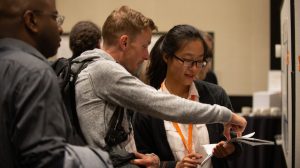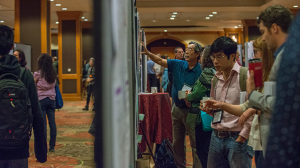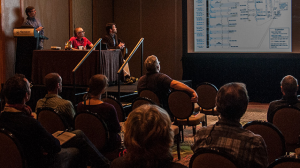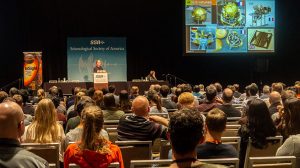 Organizing a technical session for SSA’s Annual Meeting is your opportunity to learn more about seismology and make new connections in our global community.
Organizing a technical session for SSA’s Annual Meeting is your opportunity to learn more about seismology and make new connections in our global community.
Read on for advice from our members who have organized sessions in the past!
Choose a Topic
First things first: decide on the specific focus of your session.
 Ask yourself, says Eric Calais of France’s Ecole Normale Supérieure, “What is the key question in my field that I can gather people around? Something you and a community think is important” and “triggers interest because of its novelty.”
Ask yourself, says Eric Calais of France’s Ecole Normale Supérieure, “What is the key question in my field that I can gather people around? Something you and a community think is important” and “triggers interest because of its novelty.”
Whether you decide to explore the tectonics of Mars or our meeting location in Bellevue, Earthquake Early Warning, strong motion or deep earth structure, this is your chance to steer the scientific conversation at our long-awaited, in-person annual gathering. SSA is a member-driven community, so if there’s a session you’ve wanted to attend but never seen offered, you can make it happen.
“Whatever your idea, pursue it, says Lori Dengler, Humboldt State University professor emeritus and 2017 Frank Press Public Service Award recipient. “If something occurs to you, it’s worthy of fleshing out. Bounce your ideas off of colleagues.”
Stanford University Professor Bill Ellsworth, SSA past president and the 2021 Harry Fielding Reid Medal recipient, also encourages members to connect with one another early in the planning process.
“After identifying a potential topic, discuss the idea for a session with others working on the same or related topic to sharpen the focus,” he says. “Drafting the paragraph describing the session is a good place to start.”
Create Your Session Proposal
A good proposal doesn’t need to be lengthy. It needs to captivate the interest of scientists.
 It should “identify a topic of interest to a critical mass of people” and “contain a compelling description of why a session would be useful/what it will cover and at least a few ideas for potential presenters,” says 2019 Annual Meeting Co-Chair Joan Gomberg of the U.S. Geological Survey (USGS).
It should “identify a topic of interest to a critical mass of people” and “contain a compelling description of why a session would be useful/what it will cover and at least a few ideas for potential presenters,” says 2019 Annual Meeting Co-Chair Joan Gomberg of the U.S. Geological Survey (USGS).
SRL Editor-in-Chief Allison Bent recommends using session descriptions from previous meetings as a guide: “Do some get your attention more than others? Do some leave you wondering what the session is really about? Borrow from the best and improve where needed.”
Dengler reminds members that SSA is here to help bring your proposal across the finish line. “Once submitted, there is often a second round of adjustments. Meeting conveners will look at the proposed sessions and often find there are several related topics and may suggest combining two or three sessions into a larger one. You will be included in that discussion.”
“Start thinking about specific potential speakers as you write the session proposal and reach out to those people early, soon after the sessions are accepted to generate interest and invite interesting speakers to join the session,” advises USGS Mendenhall Postdoctoral Fellow Dara Goldberg.
Find Speakers and Conveners
 Who would you like to speak at, or convene, your session?
Who would you like to speak at, or convene, your session?
“Reach out to multiple institutions in the scoping process to assemble a diverse group of conveners and viewpoints,” says Ellsworth.
“Make sure to solicit talks from those that you know will give a good and relevant talk,” says 2021 Frank Press Public Service Award Recipient Tim Ahern, the former director of IRIS Data Services.
“Be brave,” says Elizabeth Vanacore of the University of Puerto Rico, Mayaguez, a 2018 Annual Meeting co-chair. “At most meetings you meet and receive cards of other scientists who work within your specific area… reach out.” She adds that “your mentors may have contacts you do not and may be able to help you with an introductory email or phone call.”
Promote Your Session
Once your session has been approved, it’s time to spread the word.
“You can officially invite one or two speakers, then you target other relevant groups of people to publicize your session,” says Southern California Earthquake Center’s Christine Goulet, who advocates reaching out to institutions. “Most research centers and groups have their own mailing lists – for example, if your session is on national seismic hazard maps, USGS has a mailing list for that. If it’s on seismology and wave propagation, you can contact SCEC.”
Alba M. Rodríguez Padilla, a Ph.D. candidate at the University of California, Davis, says that in preparation for SSA’s 2021 Annual Meeting, “We heavily advertised our section through social media (Twitter) and on a few listservs, which resulted in a great number of submissions as well as a great turnout during the session.”
Plan and Prepare
Connect with others who have experience convening sessions, suggests Nori Nakata, a research scientist at Massachusetts Institute of Technology, and make sure you have a clear understanding of both the workload and the schedule from session proposal acceptance to the actual meeting.
Questions about submitting a session proposal? Email abstracts@seismosoc.org.
